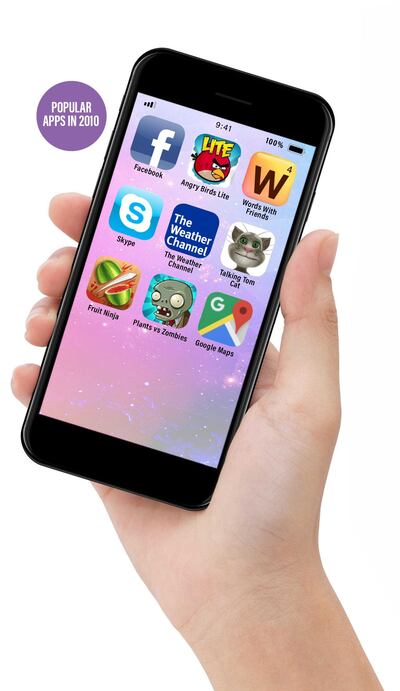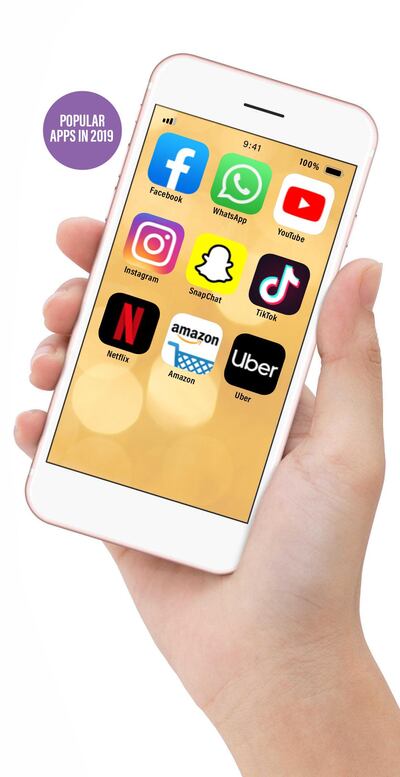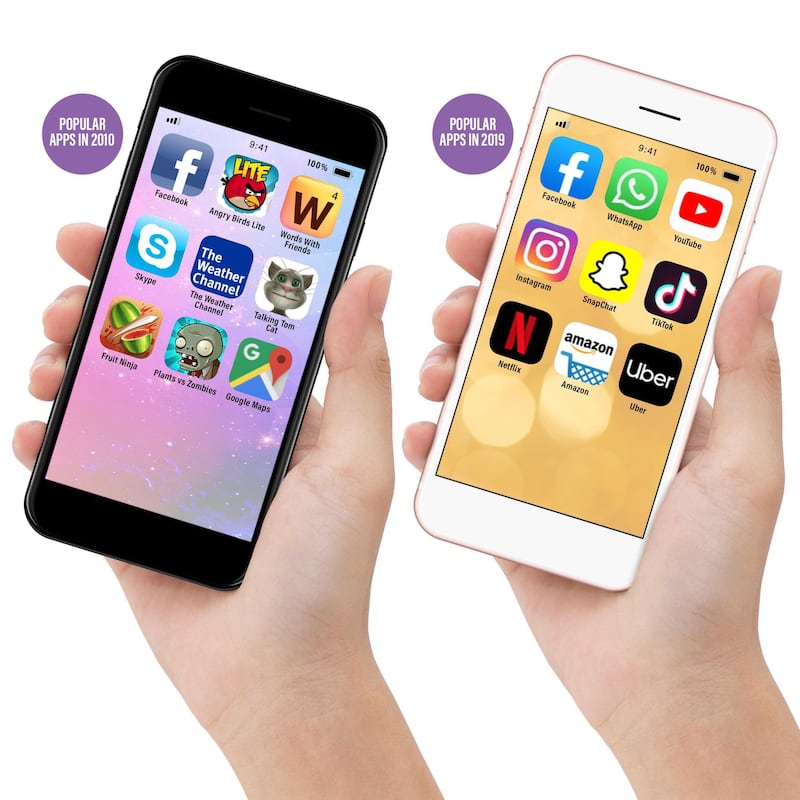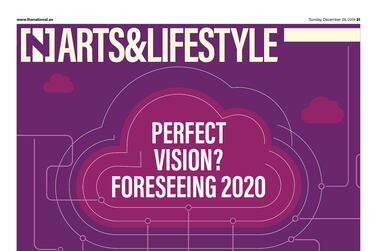Angry Birds, Words with Friends, Talking Tom Cat and Fruit Ninja … are you wondering what all these apps have in common? They were some of the most popular in 2010. Another thing they all have in common? They're probably no longer on your phone – or on the phones of those around you.
It's the end of 2019 and, in the past decade, software has gone through tumultuous changes. In 2010, the app world was relatively new; after all, the Apple App Store and Google Play (formerly the Android Market) only launched in 2008.
Top apps in 2010

According to Apple, which releases its list of top apps annually, these are some of the most popular free applications that made the cut in 2010: Facebook (which comes as no surprise), Angry Birds Lite, Words with Friends Free, Skype, Tap Tap Revenge 3, The Weather Channel, Paper Toss, Bing, Rock Band Free and Talking Tom Cat. Meanwhile, among its list of paid or part-paid apps that year were games such as Doodle Jump, Fruit Ninja, The Moron Test, Plants vs Zombies, Skee-Ball and Cut the Rope.
Facebook and Angry Birds also took the Android Market by storm in 2010. Other Android applications that proved popular that year were Amazon's Kindle for Android, Pandora Radio's free app, Foursquare, Google Maps and Evernote.
Top apps in 2019

Fast-forward to this year and, according to Apple, the most downloaded apps in 2019 were YouTube, Instagram, Snapchat, TikTok, Facebook Messenger, Gmail, Netflix, Facebook, Amazon, Spotify, DoorDash, WhatsApp, FaceApp, Uber, Yolo, Venmo, Hulu, Bitmoji and Google Chrome. Mario Kart Tour, Colour Bump 3D and Call of Duty were some of the most popular gaming apps of the year.
If there's one stark difference between the top apps of 2010 and 2019, it's the fall in demand for those that were merely for entertainment. Soraya Spahi, a digital marketing manager at luxury PR company The Qode, says there's a reason for that. "Today, there is an app for just about anything, which has made people more selective about the ones they need," she says. "Consumers are more aware that apps take up phone memory and slow down devices, which is why most apps downloaded today are to perform integral services." Talking Tom Cat and The Moron Test didn't stand a chance, then.
Communicating has never been easier
While the popularity of apps for entertainment may be on a downward spiral, one field that they have revolutionised is communication. According to mobile market data and analytics company App Annie, which this month released its top apps of the decade based on downloads, Facebook comes first, followed by Facebook Messenger, WhatsApp, Instagram, Snapchat, Skype, TikTok, UC Browser, YouTube and Twitter. With several of these also on the Apple list, it's obvious that our obsession with social media is only increasing.
TikTok, in particular, has grown exponentially over the past few years. The short-video app was the third most downloaded (outside gaming) this year, according to app analytics site Sensor Tower – putting it above Instagram in that list. So far, TikTok has been downloaded more than 1.5 billion times across the App Store and Google Play. "Social media is an addiction that has been building over the past decade, but these apps have also become essential communication tools," Spahi says.
According to her, the popularity of an app is segmented along the ages of its users. TikTok is a "rising star" popular with Generation Z, along with Snapchat. Instagram remains key for millennials, while Facebook is more popular with Gen X and baby boomers. "Basically, this just goes to show that all ages have an obsession with social media apps," she says.
The rise of social media has, in turn, paved the way for image and video editing tools. App Annie says that of the top 10 breakout apps and games (those with the largest growth in downloads or consumer spending between 2018 and 2019), four happened to be for image and video editing. This year, Apple declared the Spectre Camera to be the iPhone App of the Year. Its key attraction? Apple says it "leverages a dizzying amount of tech to let anyone take stunning, long-exposure shots".
Is this indicative of the increasing popularity of social media apps in the coming year? Spahi believes it is. She says "augmented reality" is increasingly being integrated in social media apps "to add emotion to camera-based communications like stories and snaps". With tools such as FaceApp becoming popular, we can hope to see more than top hat and puppy filters in 2020.
Functional apps trump games
Apart from social media, there has been a rise in the popularity of functional apps in the past few years – what would life be like without Google Maps, Dropbox and Gmail, after all? Another huge trend is the rise of apps that help us perform services. From ordering a taxi to renting a house, everything can be done in only a few taps.
“Today, there is hardly anything in our daily routines that is not associated with our phones,” says digital media marketer and tech blogger Omair Ahmed. “Be it finding a location, shopping, planning a holiday, ordering food or hailing a cab, we are increasingly dependent on our phones. We need apps to find new homes, decide on a hangout spot, pay fines, take care of banking, book flights and search for jobs. Everything in our real lives is connected to our virtual lives.”
As people become increasingly reliant on their phones for services, brands are rising to the challenge. In the past few years, apps have been launched in the UAE such as Cafu, which delivers fuel directly to your car (in Dubai, Sharjah and Ajman); JustMop, which ensures house cleaning services can be booked in a flash; Health at Hand, an app that sets up appointments with doctors; and laundry service Washmen, which provides pick-ups, drop-offs and next-day delivery.
"Technology continues to impact our way of life," says David Clover, associate partner at brand intimacy company MBLM. Earlier this year, the company carried out a survey researching the most popular apps in the UAE. According to its findings, WhatsApp topped the list. It was followed by Google Maps, Facebook, Instagram, Skype, Zomato, Twitter, LinkedIn, Snapchat and Uber.
"UAE consumers are technologically savvy and understand how mobile phones can help them become more connected and more capable," Clover says. "Because of this, we see a high penetration of apps that make living a little easier – food ordering and delivering, transportation, home maintenance, laundry, banking etc. This trend of online services will probably continue. Our annual Brand Intimacy study shows that brands that provide both content and services through their apps form stronger emotional bonds with their users, which ultimately sees them outperform competitors."
The UAE already has one of the highest mobile phone ownership rates in the world and, according to a nationwide YouGov / Omnibus survey last year, the average resident spends six hours a day glued to his or her screen. Clover predicts this will only increase in the years to come. "As we begin to leverage blockchain, artificial intelligence and 5G solutions, mobiles will become even more integral in how we exist and form bonds."







